Unmanned Aerial Vehicle Photogrammetry for Monitoring the Geometric Changes of Reclaimed Landfills
Abstract
1. Introduction
2. Materials and Methods
2.1. Study Area
2.2. Methodology
- xk, yk—control point image coordinates,
- x0, y0—coordinates of the camera principal point,
- fk—focal length,
- XT, YT, ZT—ground coordinates of control point,
- Xkr, Ykr, Zkr—coordinates of the center of the camera projection in the ground system.
- Preliminary Study
- Selection Study Area: Słabomierz–Krzyżówka Landfill;
- Selection of UAV type (DJI Phantom 4 RTK) and image processing software (Pix4Dmapper);
- Flight Planning, including location of GCP and check points;
- 3.1.
- Plan the height of the photogrammetric flight based on the GSD < 3 cm;
- 3.2.
- Plan the front and side coverage of the digital image block;
- 3.3.
- Determine the flight path and camera parameters (ISO, shutter speed, aperture);
- 3.4.
- Design the number and distribution of control points and check points, taking into account as much elevation variation as possible;
- Field Work
- 4.
- Establish and measure GCPs using a line–angular network by total station measurements;
- 5.
- Digital Image Acquisition;
- 5.1.
- Nadir images (AGL = 50 m, front image overlap = 90%, side image overlap = 80%, camera angle = 90°);
- 5.2.
- Oblique images (AGL = 80 m, front image overlap = 70%, side image overlap = 60%, camera angle = 60°) acquired in four different directions (north, south, west, east);
- Data Processing
- 6.
- Initial Processing;
- 7.
- Aerotriangulation with verification of control photopoints;
- 8.
- Point Cloud and Mesh generation using multi-image correlation (dense matching);
- 9.
- DSM and Orthomosaic generation;
- 10.
- Point Cloud Noise and Vegetation Filtration using Cloth Simulation Filtering (CSF) algorithm;
- 11.
- Change Calculations using M3C2 algorithm.
3. Results
- m∆Z—mean vertical displacement error,
- mZSet1—mean height error at check points (Set 1),
- mZSet2—mean height error at check points (Set 2).
4. Discussion
- Measurements should be taken on a windless day;
- There should be increased coverage of the images;
- Measurements should be taken when there is a low vegetation condition (early spring);
- There should be maintenance work before winter to eliminate vegetation.
5. Conclusions
Author Contributions
Funding
Institutional Review Board Statement
Informed Consent Statement
Data Availability Statement
Conflicts of Interest
References
- Główny Urząd Statystyczny [GUS] (2020). Składowiska (P2840). Available online: https://Bdl.Stat.Gov.Pl/Bdl/Dane/Podgrup/Tablica (accessed on 5 November 2024).
- Council Directive 1999/31/EC of April 26 1999 on the Landfill of Waste. OJ L 182/1 of 16.07.1999. Available online: https://eur-lex.europa.eu/eli/dir/1999/31/oj (accessed on 30 August 2024).
- Koda, E.; Rybak-Niedziółka, K.; Winkler, J.; Černý, M.; Osiński, P.; Podlasek, A.; Kawalec, J.; Vaverková, M.D. Space Redevelopment of Old Landfill Located in the Zone between Urban and Protected Areas: Case Study. Energies 2022, 15, 146. [Google Scholar] [CrossRef]
- Pasternak, G. Geodetic monitoring of geotechnical structures displacements: A case study of Radiowo landfill site in warsaw. Acta Sci. Pol. Archit. 2022, 21, 75–83. [Google Scholar] [CrossRef]
- Podlasek, A.; Jakimiuk, A.; Vaverková, M.D.; Koda, E. Monitoring and Assessment of Groundwater Quality at Landfill Sites: Selected Case Studies of Poland and the Czech Republic. Sustainability 2021, 13, 7769. [Google Scholar] [CrossRef]
- Koda, E.; Chormański, J.; Pasternak, G.; Osiński, P.; Jóźwiak, J. Drones Capabilities and Use in Post Remediated Landfill Sites Development Plans; ISSMGE: Chania, Greece, 2023. [Google Scholar] [CrossRef]
- Rozporządzenie Ministra Środowiska z Dnia 30 Kwietnia 2013 r. w Sprawie Składowisk Odpadów. Available online: https://isap.sejm.gov.pl/isap.nsf/DocDetails.xsp?id=WDU20130000523 (accessed on 5 August 2024).
- Adamcová, D.; Bartoň, S.; Osinski, P.; Pasternak, G.; Podlasek, A.; Vaverková, M.D.; Koda, E. Analytical Modelling of MSW Landfill Surface Displacement Based on GNSS Monitoring. Sensors 2020, 20, 5998. [Google Scholar] [CrossRef]
- Lu, S.-F.; Feng, S.-J. Comprehensive Overview of Numerical Modeling of Coupled Landfill Processes. Waste Manag. 2020, 118, 161–179. [Google Scholar] [CrossRef]
- Ren, Y.; Zhang, Z.; Huang, M. A Review on Settlement Models of Municipal Solid Waste Landfills. Waste Manag. 2022, 149, 79–95. [Google Scholar] [CrossRef]
- Sia, A.H.I.; Dixon, N. Numerical Modelling of Landfill Lining System–Waste Interaction: Implications of Parameter Variability. Geosynth. Int. 2012, 19, 393–408. [Google Scholar] [CrossRef]
- Estimation of Landfill Settlement Using Different Models|SpringerLink. Available online: https://link.springer.com/chapter/10.1007/978-981-16-1993-9_1 (accessed on 26 August 2024).
- Akhmetzyanova, L.; Usmanov, B.; Zinnatov, M.; Kuritsin, I. Monitoring the Filling of the Landfill Using the Results of Aerial Photography. E3S Web Conf. 2024, 525, 02008. [Google Scholar] [CrossRef]
- Baiocchi, V.; Napoleoni, Q.; Tesei, M.; Servodio, G.; Alicandro, M.; Costantino, D. UAV for Monitoring the Settlement of a Landfill. Eur. J. Remote Sens. 2019, 52, 41–52. [Google Scholar] [CrossRef]
- Mello, C.C.d.S.; Salim, D.H.C.; Simões, G.F. UAV-Based Landfill Operation Monitoring: A Year of Volume and Topographic Measurements. Waste Manag. 2022, 137, 253–263. [Google Scholar] [CrossRef]
- Incekara, A.H.; Delen, A.; Seker, D.Z.; Goksel, C. Investigating the Utility Potential of Low-Cost Unmanned Aerial Vehicles in the Temporal Monitoring of a Landfill. ISPRS Int. J. Geo-Inf. 2019, 8, 22. [Google Scholar] [CrossRef]
- Guo, Y.; Li, X.; Ju, S.; Lyu, Q.; Liu, T. Utilization of 3D Laser Scanning for Stability Evaluation and Deformation Monitoring of Landslides. J. Environ. Public Health 2022, 2022, 8225322. [Google Scholar] [CrossRef]
- Weidner, L.; Walton, G. Monitoring the Effects of Slope Hazard Mitigation and Weather on Rockfall along a Colorado Highway Using Terrestrial Laser Scanning. Remote Sens. 2021, 13, 4584. [Google Scholar] [CrossRef]
- Štroner, M.; Urban, R.; Línková, L. A New Method for UAV Lidar Precision Testing Used for the Evaluation of an Affordable DJI ZENMUSE L1 Scanner. Remote Sens. 2021, 13, 4811. [Google Scholar] [CrossRef]
- Kovanič, Ľ.; Blistan, P.; Urban, R.; Štroner, M.; Blišťanová, M.; Bartoš, K.; Pukanská, K. Analysis of the Suitability of High-Resolution DEM Obtained Using ALS and UAS (SfM) for the Identification of Changes and Monitoring the Development of Selected Geohazards in the Alpine Environment—A Case Study in High Tatras, Slovakia. Remote Sens. 2020, 12, 3901. [Google Scholar] [CrossRef]
- Szczygieł, J.; Golicz, M.; Hercman, H.; Lynch, E. Geological Constraints on Cave Development in the Plateau-Gorge Karst of South China (Wulong, Chongqing). Geomorphology 2018, 304, 50–63. [Google Scholar] [CrossRef]
- Salvini, R.; Mastrorocco, G.; Esposito, G.; Di Bartolo, S.; Coggan, J.; Vanneschi, C. Use of a Remotely Piloted Aircraft System for Hazard Assessment in a Rocky Mining Area (Lucca, Italy). Nat. Hazards Earth Syst. Sci. 2018, 18, 287–302. [Google Scholar] [CrossRef]
- Car, M.; Jurić Kaćunić, D.; Kovačević, M.S. Application of Unmanned Aerial Vehicle for Landslide Mapping. In Proceedings of the International Symposiun on Engineering Geodesy-SIG 2016, Varaždin, Croatia, 20–22 May 2016; pp. 549–559. [Google Scholar]
- Wan, S.; Guan, S.; Tang, Y. Advancing Bridge Structural Health Monitoring: Insights into Knowledge-Driven and Data-Driven Approaches. J. Data Sci. Intell. Syst. 2024, 2, 129–140. [Google Scholar] [CrossRef]
- Hu, K.; Chen, Z.; Kang, H.; Tang, Y. 3D Vision Technologies for a Self-Developed Structural External Crack Damage Recognition Robot. Autom. Constr. 2024, 159, 105262. [Google Scholar] [CrossRef]
- Filkin, T.; Sliusar, N.; Ritzkowski, M.; Huber-Humer, M. Unmanned Aerial Vehicles for Operational Monitoring of Landfills. Drones 2021, 5, 125. [Google Scholar] [CrossRef]
- Koda, E.; Winkler, J.; Wowkonowicz, P.; Černý, M.; Kiersnowska, A.; Pasternak, G.; Vaverková, M.D. Vegetation Changes as Indicators of Landfill Leachate Seepage Locations: Case Study. Ecol. Eng. 2022, 174, 106448. [Google Scholar] [CrossRef]
- Zaczek-Peplinska, J.; Popielski, P. Utilisation of Terrestrial Laser Scanning for Verification of Geometry of Numerical Models of Hydrotechnical Structures Using the Example of a Section of the Concrete Besko Dam. Czas. Tech. Śr. 2013, 110, 153–164. [Google Scholar]
- Kršák, B.; Blišťan, P.; Pauliková, A.; Puškárová, P.; Kovanič, Ľ.; Palková, J.; Zelizňaková, V. Use of Low-Cost UAV Photogrammetry to Analyze the Accuracy of a Digital Elevation Model in a Case Study. Measurement 2016, 91, 276–287. [Google Scholar] [CrossRef]
- Champagne, C.L.; Zekkos, D.; Lynch, J.P.; O’Laughlin, S. Waste Settlement Measurements Using Unmanned Aerial Vehicles at a Municipal Solid Waste Landfill in Michigan. In Geo-Congress 2020; American Society of Civil Engineers: Reston, VA, USA, 2020; pp. 249–258. [Google Scholar] [CrossRef]
- Wyard, C.; Beaumont, B.; Grippa, T.; Hallot, E. UAV-Based Landfill Land Cover Mapping: Optimizing Data Acquisition and Open-Source Processing Protocols. Drones 2022, 6, 123. [Google Scholar] [CrossRef]
- Sliusar, N.; Filkin, T.; Huber-Humer, M.; Ritzkowski, M. Drone Technology in Municipal Solid Waste Management and Landfilling: A Comprehensive Review. Waste Manag. 2022, 139, 1–16. [Google Scholar] [CrossRef]
- Staats, T.P. Photogrammetry UAV and Terrestrial LiDAR, a Comparative Review in Volumetric Surveys. Available online: https://sear.unisq.edu.au/51843/ (accessed on 26 August 2024).
- Nikulishyn, V.; Savchyn, I.; Lompas, O.; Lozynskyi, V. Applying of Geodetic Methods for Monitoring the Effects of Waste-Slide at Lviv Municipal Solid Waste Landfill. Environ. Nanotechnol. Monit. Manag. 2020, 13, 100291. [Google Scholar] [CrossRef]
- Gasperini, D.; Allemand, P.; Delacourt, C.; Grandjean, P. Potential and Limitation of UAV for Monitoring Subsidence in Municipal Landfills. Int. J. Environ. Technol. Manag. 2014, 17, 1–13. [Google Scholar] [CrossRef]
- Winkler, J.; Koda, E.; Skutnik, Z.; Černý, M.; Adamcová, D.; Podlasek, A.; Vaverková, M.D. Trends in the succession of synanthropic vegetation on a reclaimed landfill in Poland. Anthropocene 2021, 35, 100299. [Google Scholar] [CrossRef]
- Koda, E.; Miszkowska, A.; Osinski, P.; Sieczka, A. Heavy Metals Contamination within Restored Landfill Site in Poland. Environ. Geotech. 2018, 7, 512–521. [Google Scholar] [CrossRef]
- Koda, E.; Osiński, P.; Podlasek, A.; Markiewicz, A.; Winkler, J.; Vaverková, M.D. Geoenvironmental Approaches in an Old Municipal Waste Landfill Reclamation Process: Expectations vs Reality. Soils Found. 2023, 63, 101273. [Google Scholar] [CrossRef]
- Podlasek, A.; Vaverková, M.D.; Koda, E.; Jakimiuk, A.; Martínez Barroso, P. Characteristics and Pollution Potential of Leachate from Municipal Solid Waste Landfills: Practical Examples from Poland and the Czech Republic and a Comprehensive Evaluation in a Global Context. J. Environ. Manag. 2023, 332, 117328. [Google Scholar] [CrossRef]
- Gorecka, A.; Koda, E. Analiza możliwości ograniczenia zagrożeń środowiska wodno-gruntowego, wynikających z eksploatacji modernizowanego składowiska odpadów komunalnych. Sci. Rev. Eng. Environ. Sci. 2010, 19, 48–62. [Google Scholar]
- Koda, E.; Kiersnowska, A.; Kawalec, J.; Osiński, P. Landfill Slope Stability Improvement Incorporating Reinforcements in Reclamation Process Applying Observational Method. Appl. Sci. 2020, 10, 1572. [Google Scholar] [CrossRef]
- Pyka, K.; Wiącek, P.; Guzik, M. Surveying with Photogrammetric Unmanned Aerial Vehicles. Arch. Fotogram. Kartogr. Teledetekcji 2020, 32, 79–102. [Google Scholar] [CrossRef]
- Pasternak, G.; Zaczek-Peplinska, J.; Pasternak, K.; Jóźwiak, J.; Pasik, M.; Koda, E.; Vaverková, M.D. Surface Monitoring of an MSW Landfill Based on Linear and Angular Measurements, TLS, and LIDAR UAV. Sensors 2023, 23, 1847. [Google Scholar] [CrossRef]
- Yu, D.; He, L.; Ye, F.; Jiang, L.; Zhang, C.; Fang, Z.; Liang, Z. Unsupervised Ground Filtering of Airborne-Based 3D Meshes Using a Robust Cloth Simulation. Int. J. Appl. Earth Obs. Geoinf. 2022, 111, 102830. [Google Scholar] [CrossRef]
- Li, F.; Zhu, H.; Luo, Z.; Shen, H.; Li, L. An Adaptive Surface Interpolation Filter Using Cloth Simulation and Relief Amplitude for Airborne Laser Scanning Data. Remote Sens. 2021, 13, 2938. [Google Scholar] [CrossRef]
- Cai, S.; Yu, S. Filtering Airborne LiDAR Data in Forested Environments Based on Multi-Directional Narrow Window and Cloth Simulation. Remote Sens. 2023, 15, 1400. [Google Scholar] [CrossRef]
- Mohd Asri, M.K. Accuracy Assessment of Digital Terrain Model (DTM) Constructed Cloth Simulation Filter (CSF) and Multi Curvature Classification (MCC) Algorithm on UAV LiDAR Dataset/Mohamad Khairan Mohd Asri. Available online: https://ir.uitm.edu.my/id/eprint/87822/ (accessed on 26 August 2024).
- Zhang, W.; Qi, J.; Wan, P.; Wang, H.; Xie, D.; Wang, X.; Yan, G. An Easy-to-Use Airborne LiDAR Data Filtering Method Based on Cloth Simulation. Remote Sens. 2016, 8, 501. [Google Scholar] [CrossRef]
- Lague, D.; Brodu, N.; Leroux, J. Accurate 3D Comparison of Complex Topography with Terrestrial Laser Scanner: Application to the Rangitikei Canyon (N-Z). ISPRS J. Photogramm. Remote Sens. 2013, 82, 10–26. [Google Scholar] [CrossRef]
- DiFrancesco, P.-M.; Bonneau, D.; Hutchinson, D.J. The Implications of M3C2 Projection Diameter on 3D Semi-Automated Rockfall Extraction from Sequential Terrestrial Laser Scanning Point Clouds. Remote Sens. 2020, 12, 1885. [Google Scholar] [CrossRef]
- Benjamin, J.; Rosser, N.J.; Brain, M.J. Rockfall Detection and Volumetric Characterisation Using LiDAR. In Landslides and Engineered Slopes. Experience, Theory and Practice; CRC Press: Boca Raton, FL, USA, 2016; ISBN 978-1-315-37500-7. [Google Scholar]
- Van Veen, M.; Hutchinson, D.J.; Kromer, R.; Lato, M.; Edwards, T. Effects of Sampling Interval on the Frequency—Magnitude Relationship of Rockfalls Detected from Terrestrial Laser Scanning Using Semi-Automated Methods. Landslides 2017, 14, 1579–1592. [Google Scholar] [CrossRef]
- Benjamin, J. Regional-Scale Controls on Rockfall Occurrence. Ph.D. Thesis, Durham University, Durham, UK, 2018. [Google Scholar]
- Kromer, R.A.; Abellán, A.; Hutchinson, D.J.; Lato, M.; Edwards, T.; Jaboyedoff, M. A 4D Filtering and Calibration Technique for Small-Scale Point Cloud Change Detection with a Terrestrial Laser Scanner. Remote Sens. 2015, 7, 13029–13052. [Google Scholar] [CrossRef]
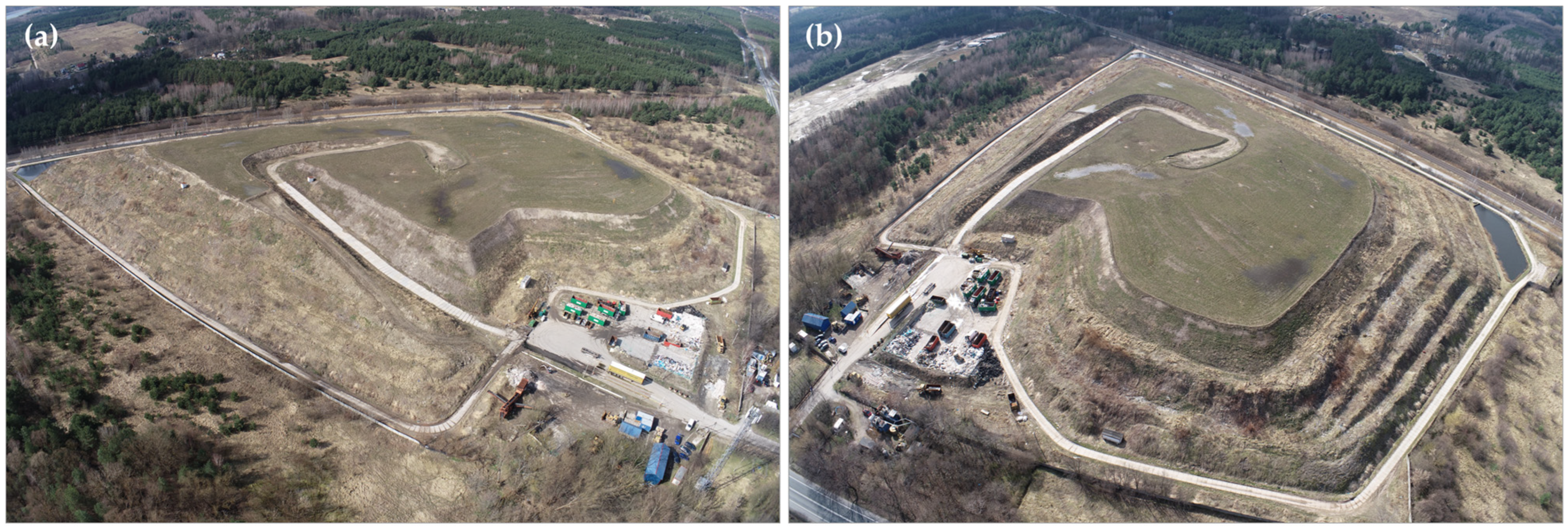
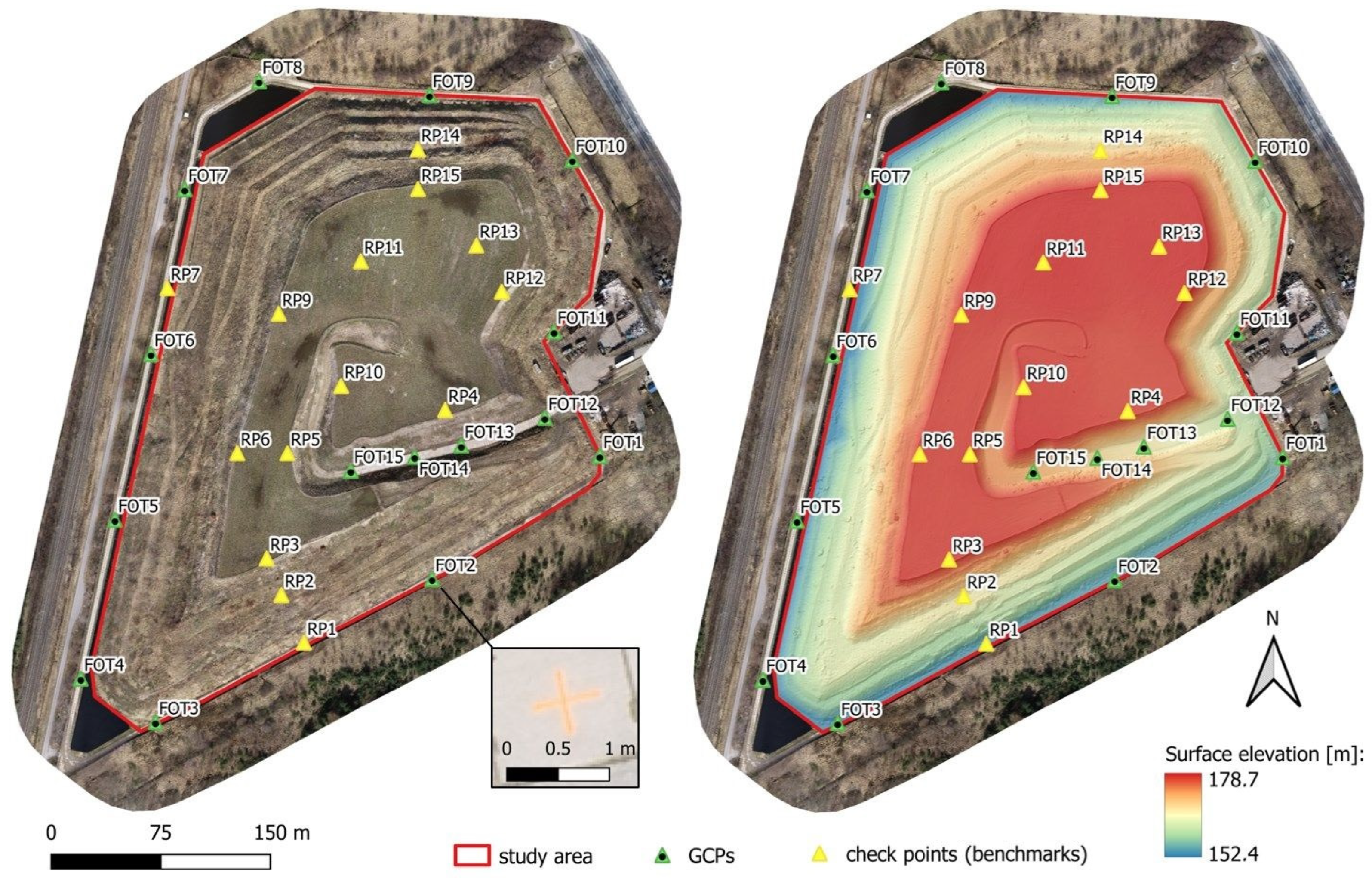
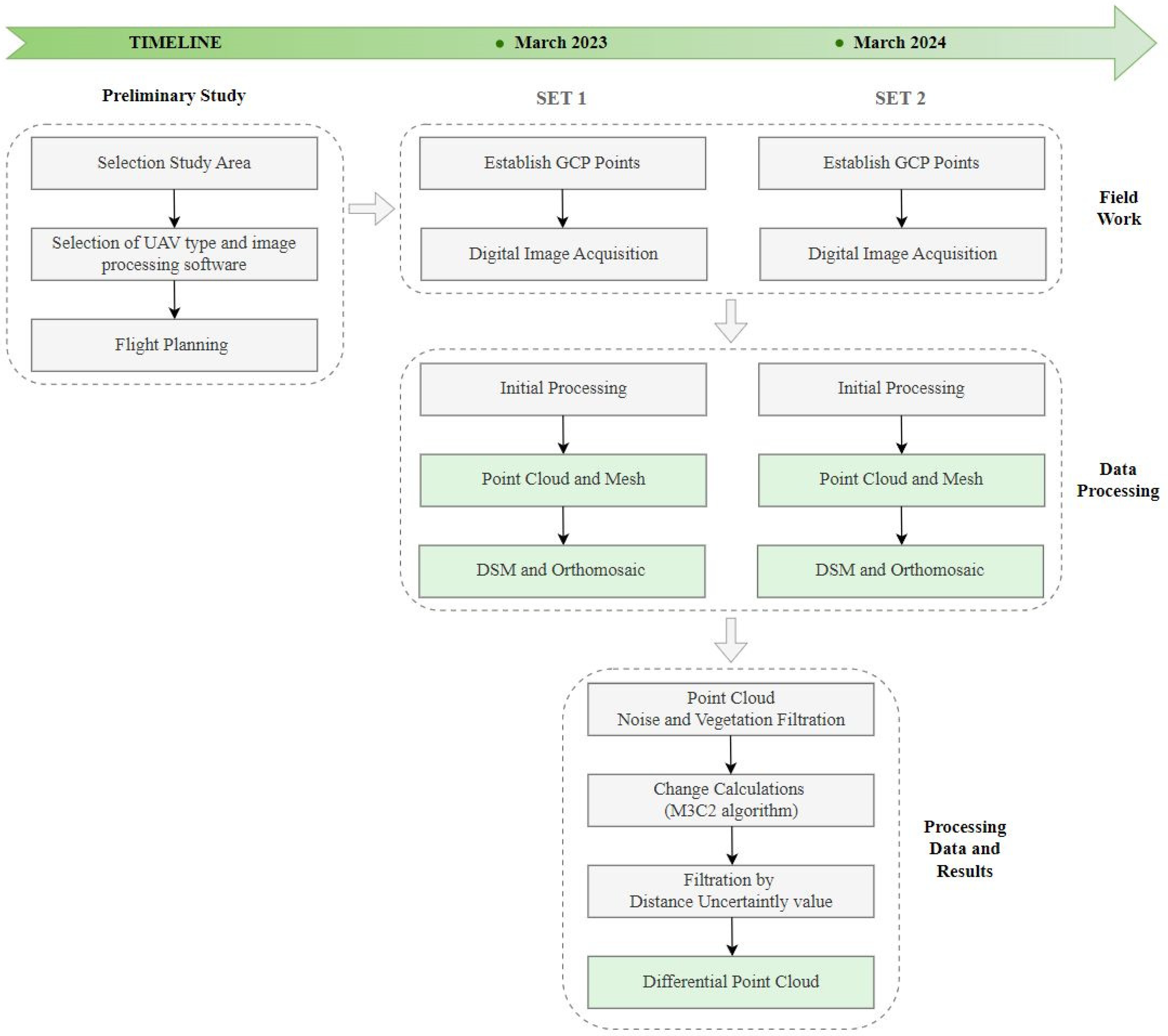
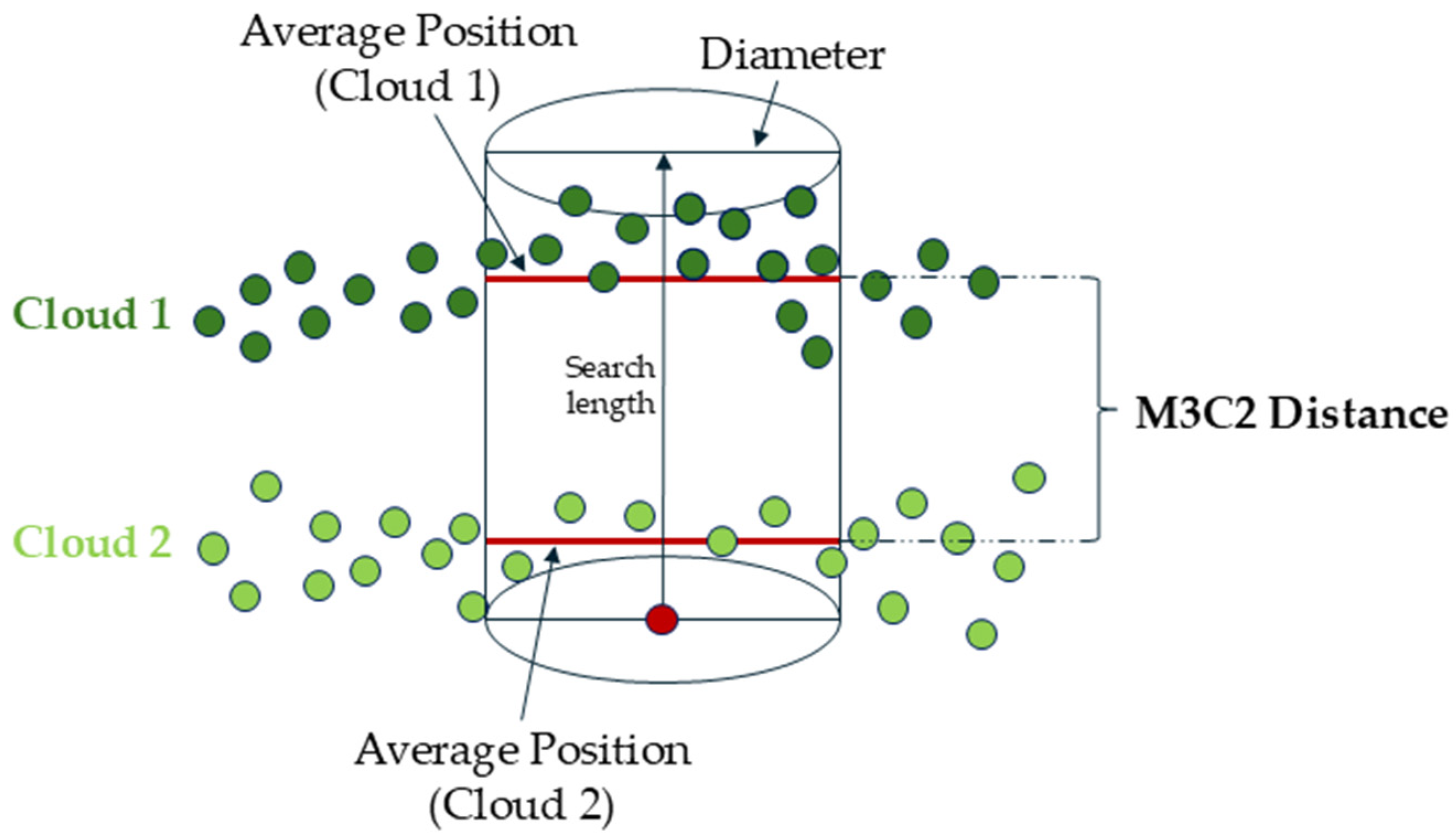
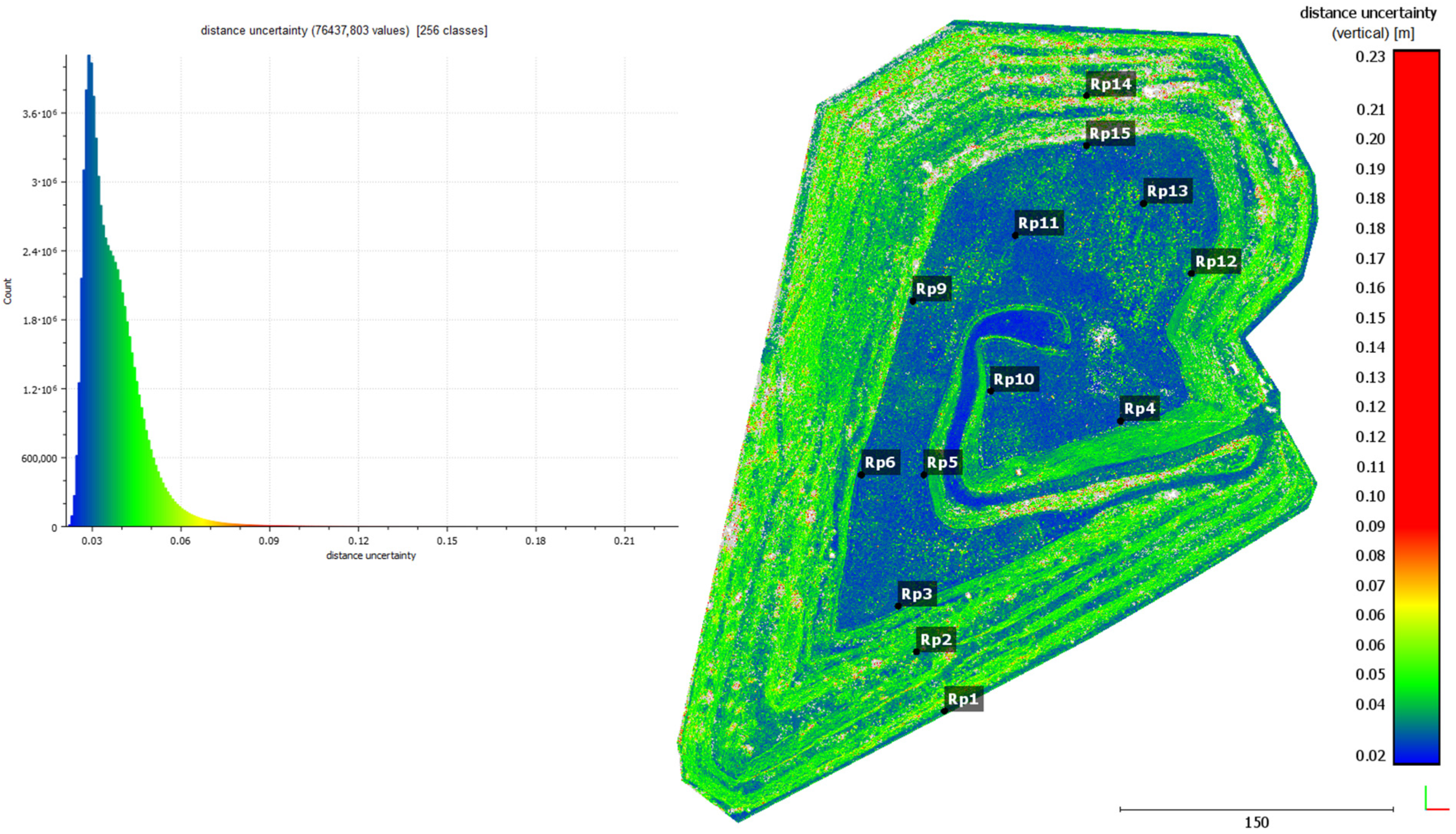
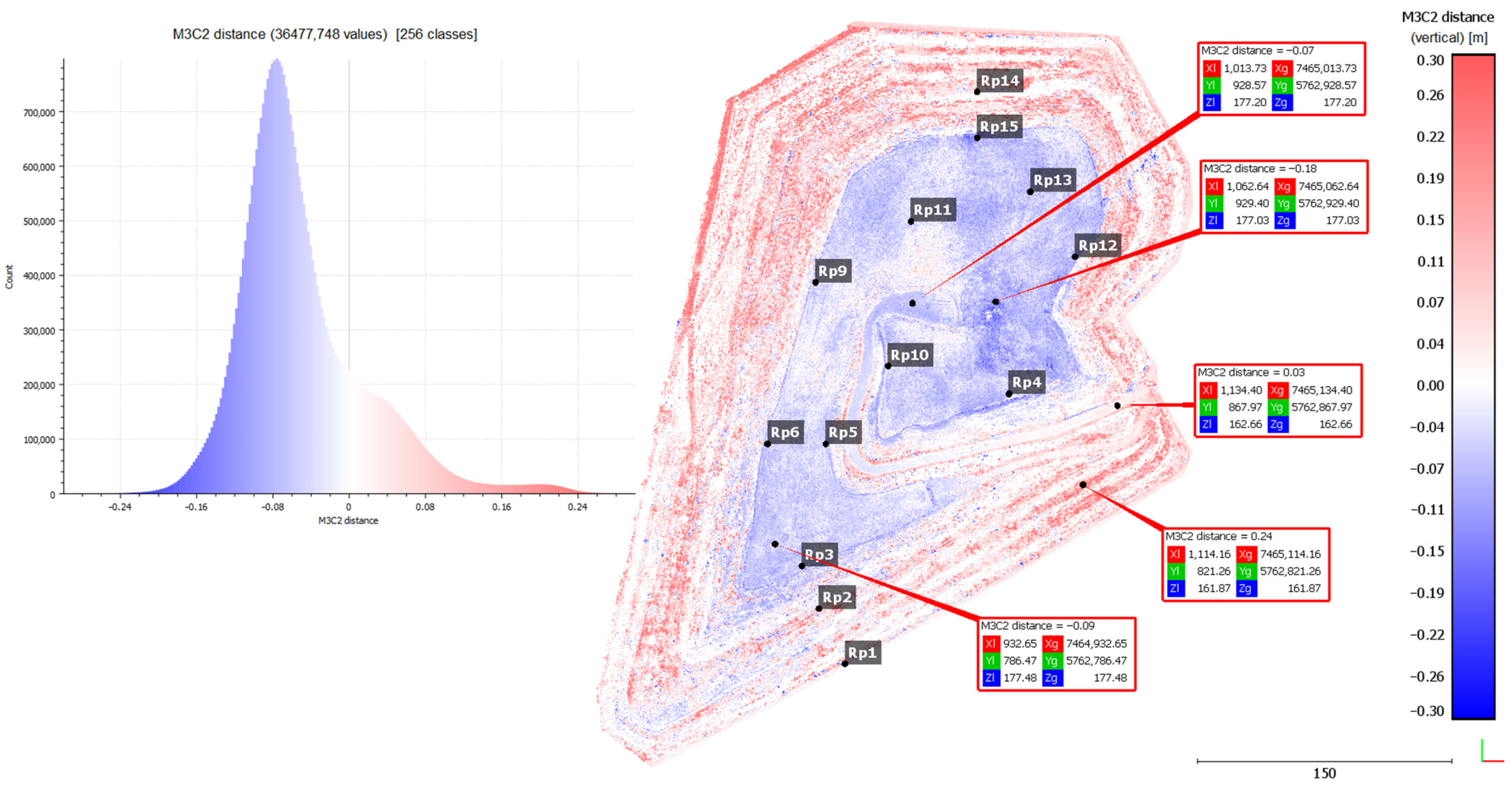


| Data Set | Date | Images | GSD [cm] | GCPs | RMSE [m] | Average Point Cloud Density [per m3] | Check- Points | Check Points RMSE [m] | ||
|---|---|---|---|---|---|---|---|---|---|---|
| Error XY | Error Z | Error XY | Error Z | |||||||
| Set 1 | March 2023 | 1621 | 1.84 | 15 | 0.006 | 0.008 | 412 | 14 | 0.011 | 0.017 |
| Set 2 | March 2024 | 1166 | 2.57 | 15 | 0.008 | 0.006 | 229 | 14 | 0.009 | 0.016 |
| Pix4Dmapper Parameters: | |
|---|---|
| Mode: | Standard 3D Maps |
| Initial processing: |
|
| Point cloud and mesh: |
|
| DSM and orthomosaic: |
|
| Point No. | Vertical Displacements [m] | |||
|---|---|---|---|---|
| Leveling | UAV Photogrammetry | Difference | Vegetation | |
| RP1 | 0.010 | 0.010 | 0.000 | low |
| RP2 | −0.005 | 0.040 | 0.045 | high |
| RP3 | −0.087 | −0.110 | −0.023 | low |
| RP4 | −0.138 | −0.130 | 0.008 | low |
| RP5 | −0.083 | −0.070 | 0.013 | low |
| RP6 | −0.089 | −0.070 | 0.019 | low |
| RP9 | −0.106 | −0.090 | 0.016 | low |
| RP10 | −0.094 | −0.080 | 0.014 | low |
| RP11 | −0.101 | −0.070 | 0.031 | low |
| RP12 | −0.148 | −0.110 | 0.038 | medium |
| RP13 | −0.130 | −0.110 | 0.020 | low |
| RP14 | −0.008 | −0.010 | −0.002 | medium |
| RP15 | −0.179 | −0.170 | 0.009 | low |
| Mean: | 0.014 | |||
Disclaimer/Publisher’s Note: The statements, opinions and data contained in all publications are solely those of the individual author(s) and contributor(s) and not of MDPI and/or the editor(s). MDPI and/or the editor(s) disclaim responsibility for any injury to people or property resulting from any ideas, methods, instructions or products referred to in the content. |
© 2024 by the authors. Licensee MDPI, Basel, Switzerland. This article is an open access article distributed under the terms and conditions of the Creative Commons Attribution (CC BY) license (https://creativecommons.org/licenses/by/4.0/).
Share and Cite
Pasternak, G.; Pasternak, K.; Koda, E.; Ogrodnik, P. Unmanned Aerial Vehicle Photogrammetry for Monitoring the Geometric Changes of Reclaimed Landfills. Sensors 2024, 24, 7247. https://doi.org/10.3390/s24227247
Pasternak G, Pasternak K, Koda E, Ogrodnik P. Unmanned Aerial Vehicle Photogrammetry for Monitoring the Geometric Changes of Reclaimed Landfills. Sensors. 2024; 24(22):7247. https://doi.org/10.3390/s24227247
Chicago/Turabian StylePasternak, Grzegorz, Klaudia Pasternak, Eugeniusz Koda, and Paweł Ogrodnik. 2024. "Unmanned Aerial Vehicle Photogrammetry for Monitoring the Geometric Changes of Reclaimed Landfills" Sensors 24, no. 22: 7247. https://doi.org/10.3390/s24227247
APA StylePasternak, G., Pasternak, K., Koda, E., & Ogrodnik, P. (2024). Unmanned Aerial Vehicle Photogrammetry for Monitoring the Geometric Changes of Reclaimed Landfills. Sensors, 24(22), 7247. https://doi.org/10.3390/s24227247








